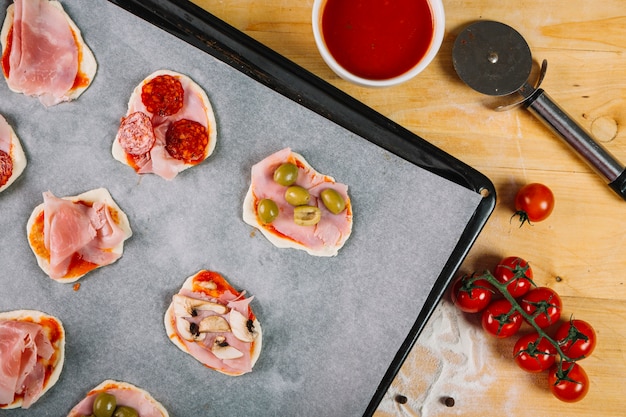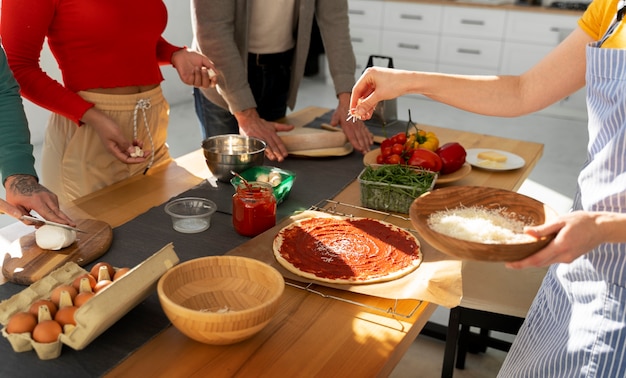It’s that time again: the festive season is upon us, and the aroma of Christmas dinner is already swirling in the air. And what’s a Christmas dinner without a glorious ham, the centerpiece of the feast? Over the years, I’ve experimented with various techniques – from traditional roasting to innovative glazes – and I’ve gathered a wealth of knowledge to share with you. This isn’t just a guide to cooking a ham; it’s a journey to elevate it to the star of your Christmas table. Buckle up, because we’re about to embark on a delicious adventure!
(Part 1) Choosing the perfect ham

The first step, and perhaps the most important, is selecting the right ham. It sets the stage for the entire experience, so let's get it right!
1. Boned or Whole? The Great Debate
This is a classic dilemma. boneless hams are a breeze to handle. They’re usually pre-sliced, making carving a breeze, and often come with a fancy glaze already on them. But for me, a whole ham has that nostalgic Christmas charm, and the bone-in flavour is unparalleled. The bone adds a depth of flavour that’s simply irreplaceable, but it does require a bit more effort during carving.
2. Smoked or Unsmoked: A Matter of Taste
smoked hams have a lovely smoky aroma and are ready to eat as soon as you unwrap them. They’re a lifesaver for busy days, offering a quick and easy solution. Unsmoked hams, however, are a blank canvas, allowing you to unleash your creativity. You can glaze them, infuse them with herbs, or even roast them with fruit for a sweet and savoury flavour symphony.
3. Size and Serving: A Culinary Calculation
The size of the ham you choose depends on the number of guests you're expecting. A small ham can comfortably feed 4-6 people, while a large one can easily handle 10-12 hungry guests. Always err on the side of too much, especially during the holidays. You don’t want to be caught short!
(Part 2) Prepping for Perfection: Preparing the Ham

Now that you've chosen your star player, it’s time to prep it for its grand entrance.
1. Unveiling the Ham: A Fresh Start
Remove the ham from its packaging and give it a thorough rinse under cold water. This removes any excess salt or preservatives and allows it to breathe, ready for its transformation.
2. Scoring the Ham: A Culinary Art
Scoring the ham isn’t just about aesthetics; it's a crucial step for even cooking and glaze penetration. Using a sharp knife, make diagonal cuts across the fat, about 1 cm deep. This allows the heat to reach every corner of the ham and ensures a beautiful, even finish.
3. Brining the Ham: A Delicious Debate (Optional)
Ah, brining. It’s a controversial topic among culinary enthusiasts. Some swear by it, while others believe it’s unnecessary. I, however, stand firmly on the side of brining. A good brine adds moisture and flavour to the ham, making it incredibly juicy and tender.
For a simple brine, combine equal parts water and salt in a large bowl. Add a cup of sugar for extra sweetness, and toss in a few aromatic ingredients like bay leaves, peppercorns, or even a sprig of rosemary. Submerge the ham in the brine for 24 hours in the fridge. The results are truly transformative.
(Part 3) Cooking the Ham: Unlocking its Potential

Now comes the fun part: cooking the ham! Choose the method that best suits your time and preferences.
1. Oven Baking: A Classic Choice
For traditional, slow-roasted flavour, the oven is a reliable companion. Preheat your oven to 325°F (160°C). Place the ham on a roasting rack in a baking dish, ensuring it’s not sitting in any accumulated juices. Cover the ham loosely with foil and bake for about 15-20 minutes per pound. The foil helps trap moisture, creating a beautifully tender ham.
2. slow cooker Magic: Effortless Delight
If you prefer hands-off cooking, the slow cooker is your culinary ally. Place the ham in the slow cooker, cover it with water or broth, and cook on low for 6-8 hours. The slow cooker method yields a meltingly tender ham, perfect for a stress-free holiday.
3. instant pot Power: Time-Saving Triumph
When time is of the essence, the Instant Pot is a true lifesaver. Place the ham in the Instant Pot, add a cup of water or broth, and cook on high pressure for 30-40 minutes per pound. Let it naturally release for 15 minutes before releasing the pressure manually. The Instant Pot method delivers a perfectly cooked ham with minimal effort.
(Part 4) Glazing the Ham: The Finishing Touch
The glaze is the crowning glory, adding a burst of flavour and visual appeal. It’s the finishing touch that elevates your ham to a culinary masterpiece.
1. Classic Glaze: A Timeless Favourite
A classic glaze usually includes brown sugar, honey, mustard, and a touch of vinegar. The sweetness of the brown sugar and honey blends beautifully with the tanginess of the mustard and vinegar, creating a harmonious flavour profile. Combine the ingredients in a saucepan and simmer until it thickens, creating a luscious glaze. Brush it generously over the ham during the last 30 minutes of cooking, allowing it to caramelize and create a gorgeous crust.
2. Fruity Glaze: A Festive Twist
For a festive touch, add some fruit to your glaze. Apricot jam, orange marmalade, or even cranberry sauce offer a sweet and tart glaze, perfectly complementing the savoury ham. Combine with a touch of mustard or balsamic vinegar for an added layer of complexity. The fruity notes add a touch of elegance and sophistication to your festive spread.
3. Spicy Glaze: A culinary adventure
If you’re looking for a bold flavour experience, a spicy glaze is the perfect choice. Combine brown sugar, honey, and a touch of chili powder or cayenne pepper for a gentle kick. For a more intense heat, use hot honey or a chipotle paste. The spicy glaze adds a tantalizing element, making your ham truly unforgettable.
(Part 5) Carving the Ham: A Skillful Art
Carving the ham is a delicate art, demanding patience and precision. It’s the moment of truth, where your culinary masterpiece is revealed in all its glory.
1. Cooling and Resting: A Moment of Patience
Once the ham is cooked, resist the urge to carve immediately. Let it rest for 15-20 minutes before carving. This allows the juices to redistribute throughout the meat, resulting in a more tender and flavourful ham.
2. Carving Techniques: Mastering the Craft
Use a sharp carving knife and make thin slices, showcasing the beautiful layers of the ham. Start by carving off the outer layer of fat, which can be discarded or used to make a delicious soup stock. Next, carve the ham into thin slices, following the grain of the meat. This ensures clean cuts and prevents the meat from shredding.
(Part 6) Serving the Ham: A Culinary Celebration
The time has come to unveil your masterpiece! The aroma is intoxicating, the presentation is stunning, and the anticipation is palpable.
1. Accompaniments: A Symphony of Flavours
There’s no shortage of delicious accompaniments to complement your Christmas ham. Roasted vegetables, like Brussels sprouts or sweet potatoes, add a vibrant touch. Creamy mashed potatoes offer a comforting contrast, while a tangy cranberry sauce provides a burst of acidity. Don't forget a good bread roll or two for soaking up all those delicious juices!
2. Leftover Inspiration: A Culinary Treasure Trove
leftover ham is a true treasure, offering endless possibilities for creative culinary adventures. Chop it up and add it to a quiche, a salad, or a frittata. It can also be incorporated into a pasta bake or a hearty ham and bean soup. The possibilities are endless!
(Part 7) Storing the Ham: Preserving the Goodness
After all the feasting, it’s important to store the remaining ham properly to preserve its flavour and quality.
1. Refrigerating: Keeping It Fresh
Leftover ham should be refrigerated in an airtight container for up to 4 days. This ensures it remains fresh and flavorful, ready for your next culinary creation.
2. Freezing: Saving It for Later
You can also freeze leftover ham for up to 2 months. Wrap it tightly in plastic wrap and then in foil for extra protection. When you're ready to use it, thaw it in the refrigerator overnight.
(Part 8) Tips and Tricks: Mastering the Craft
Here are a few extra tips and tricks to help you elevate your ham to new heights.
1. The water bath: Adding Moisture
For extra moisture, consider using a water bath while cooking the ham. Place the ham in a roasting pan and add about 1 cup of water to the bottom of the pan. The steam created by the water bath will keep the ham moist and tender.
2. ham glaze Inspiration: Exploring Flavors
If you're feeling adventurous, try infusing your ham with aromatic herbs. Add a few sprigs of rosemary, thyme, or bay leaves to the roasting pan or slow cooker. The herbs will impart their subtle flavours to the ham, creating a truly unique and memorable experience.
(Part 9) FAQs
1. How long does it take to cook a ham?
The cooking time for a ham depends on its size and whether it's bone-in or boneless. A general rule of thumb is to cook a ham for 15-20 minutes per pound in a 325°F (160°C) oven.
2. What is the best temperature for cooking a ham?
The ideal internal temperature for a cooked ham is 145°F (63°C). You can use a meat thermometer to check the temperature, ensuring it's cooked to perfection.
3. Can you overcook a ham?
Yes, you can definitely overcook a ham. An overcooked ham will be dry and tough. To prevent this, ensure you cook the ham at the correct temperature and for the appropriate time.
4. Can you eat ham cold?
Absolutely! Ham is delicious cold, and it's often served as part of a cold buffet or on sandwiches. It's a versatile ingredient that can be enjoyed hot or cold.
5. What should I do if my ham is dry?
If your ham is dry, there are a few things you can do. You can try adding some moisture by serving it with a sauce or glaze. You can also slice it thinly and use it in a recipe where it will absorb some moisture, such as a quiche or a soup.
Final Thoughts
There you have it: the ultimate guide to cooking a delicious Christmas ham! Remember, the key is to choose the right ham, prepare it with care, and cook it slowly and patiently. With a little effort, you can create a stunning centerpiece for your Christmas dinner that everyone will adore. So, go forth and conquer the kitchen, and happy holidays!
Everyone is watching

Prime Rib Roast Cooking Time Chart: Per Pound Guide
Cooking TipsPrime rib roast. Just the name conjures images of lavish dinners, crackling fires, and hearty laughter. It’s ...

How Long to Bake Potatoes in the Oven (Perfect Every Time)
Cooking TipsBaked potatoes are a staple in my kitchen. They're incredibly versatile, delicious, and surprisingly easy to m...

Perfect Rice Every Time: The Ultimate Guide to Cooking Rice
Cooking TipsAs a self-proclaimed foodie, I've always been a bit obsessed with rice. It's the foundation of countless cuisi...

The Ultimate Guide to Cooking Asparagus: Tips, Techniques, and Recipes
Cooking TipsAsparagus. The mere mention of this spring delicacy conjures up images of vibrant green spears, crisp and burs...

Ultimate Guide to Cooking the Perfect Thanksgiving Turkey
Cooking TipsThanksgiving. Just the word conjures up images of overflowing tables laden with delicious food, the scent of r...
